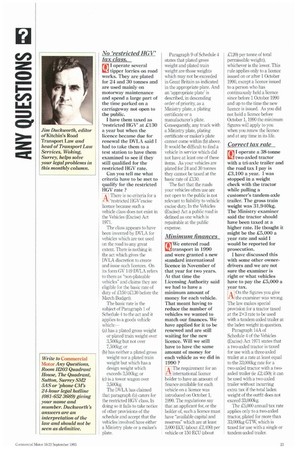No 'restricted HGV' tax class.
Page 25

If you've noticed an error in this article please click here to report it so we can fix it.
I operate several tipper lorries on road works. They are plated for 24 and 30 tonnes and are used mainly on motorway maintenance and spend a large part of the time parked on a carriageway not open to the public.
I have them taxed as 'restricted HGV' at £130 a year but when the licence became due for renewal the DVLA said I had to take them to a test station to have them examined to see if they still qualified for the restricted HGV rate.
Can you tell me what criteria have to be met to qualify for the restricted HGV rate ?
A There is no criteria for a In'restricted HGV'excise licence because such a vehicle class does not exist in the Vehicles (Excise) Act 1971.
The class appears to have been invented by DVLA for vehicles which are not used on the road to any great extent. There is nothing in the act which gives the OVLA discretion to create and issue such licences. On its form GV 149 DVLA refers to them as "non-plateable vehicles" and claims they are eligible for the basic rate of duty of £150 (0C130 before the March Budget).
The basic rate is the subject of Paragraph 1 of Schedule 4 to the act and it applies to a goods vehicle which:— (a) has a plated gross weight or plated train weight over 3,500kg but not over 7,500kg; or (b) has neither a plated gross weight nor a plated train weight but which has a design weight which exceeds 3,500kg: or (c) is a tower wagon over 3,500kg.
The DVLA has claimed that paragraph (b) caters for the restricted HGV class. In doing so it fails to take notice of other provisions of the schedule and accept that the vehicles involved have either a Ministry plate or a maker's plate. Paragraph 9 of Schedule 4 states that plated gross weight and plated train weight are those weights which may not be exceeded in Great Britain as indicated in the appropriate plate. And an 'appropriate plate' is described, in descending order of priority, as a Ministry plate, a plating certificate or a manufacturer's plate. Consequently, any truck with a Ministry plate, plating certificate or maker's plate cannot come within (b) above. It would be difficult to find a vehicle in service which did not have at least one of these items. As your vehicles are plated for 24 and 30 tonnes they cannot be taxed at the basic rate of £150.
The fact that the roads your vehicles often use are not open to the public is not relevant to liability to vehicle excise duty In the Vehicles (Excise) Act a public road is defined as one which is repairable at the public expense.
Minimum finances
We entered road transport in 1990 and were granted a new standard international licence in November of that year for two years. At that time the Licensing Authority said we had to have a minimum amount of money for each vehicle. That meant having to reduce the number of vehicles we wanted to match our finances. We have applied for it to be renewed and are still waiting for the new licence. Will we still have to have the same amount of money for each vehicle as we did in 1990?
A The requirement for an -2-1international licence holder to have an amount of finance available for each vehicle on a licence was introduced on October 1, 1990. The regulations say that an applicant for, or the holder of, such a licence must have "available capital and reserves" which are at least 3,000 ECU (about £2,400) per vehicle or 150 ECU (about £120) per tonne of total permissible weight), whichever is the lower. This rule applies only to a licence issued on or after 1 October 1990, except a licence issued to a person who has continuously held a licence since before 1 October 1990 and up to the time the new licence is issued. As you did not hold a licence before October 1, 1990 the minimum figures will apply to you when you renew the licence and at any time in its life.
Correct tax rate
I operate a 38-tonne two-axled tractor with a tri-axle trailer and the road tax I pay is £3,100 a year. I was stopped in a weight check with the tractor while pulling a customer's tandem-axle trailer. The gross train weight was 31,940kg. The Ministry examiner said the tractor should have been taxed at a higher rate. He thought it might be the £5,000 a year rate and said I would be reported for prosecution.
I have discussed this with some other ownerdrivers and we are not sure the examiner is right or what vehicles have to pay the £5,000 a year tax.
I A I On the -figures you give 1-tilthe examiner was wrong. The law makes special provision for a tractor taxed at the 2+3 rate to be used with a tandem-axled trailer at the laden weight in question.
Paragraph 14A of Schedule 4 of the Vehicles (Excise) Act 1971 states that a two-axled tractor is taxed for use with a three-axled trailer at a rate at least equal to the 33,000kg rate for a two-axled tractor with a twoaxled trailer (ie £2,450); it can be used with a two-axled trailer without incurring extra tax if the total laden weight of the outfit does not exceed 33,000kg, The £5,000 annual tax rate applies only to a two-axled tractor, plated for more than 33,000kg GTW, which is taxed for use with a single or tandem-aided trailer.


























































































